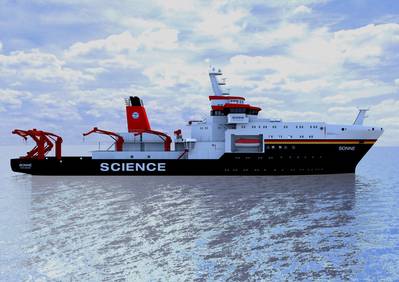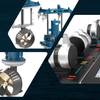Imtech Designs for Energy-Efficient Research Vessel
Imtech Marine provides complete Heating, Ventilation and Air Conditioning to new eco-friendly Research Vessel ‘Sonne’. Energy savings realized by Dynamic Simulation techniques.
Imtech Marine was selected as supplier of the new Research Vessel ‘Sonne’. Imtech designs and installs the complete HVAC system for accommodation areas, laboratories and machinery spaces, as well as the redundant cold and warm water supply system with a combination of turbo chillers and absorption chillers. After 44 years the current German research vessel ‘Sonne’ will be replaced by a new, eco-friendly and energy-efficient successor in the beginning of 2015, carrying the same name. The new ‘Sonne’ is currently under construction at the Meyer Werft shipyard in Papenburg, Germany, and will be going on scientific expeditions around the world 345 days per year like its predecessor. The vessel will contribute to find answers to relevant questions regarding the climate change, the supply of marine raw materials and the interference of humans with the sensitive marine ecosystem. By applying dynamic simulation techniques, Imtech Marine provides solutions achieving substantial energy savings on the HVAC system.
- Dynamic Simulations
The project requires specific technical expertise, for example with regard to the demands of two climate laboratories on board at a temperature range between 0°C and 28°C. Also the requirements with regard to energy savings are high. With the help of dynamic simulations, Imtech Marine reduces the overall energy consumption of the ship by means of an elaborate regulation and automation of the cold water supply systems. Other challenges concern the short building time, the limited space available and the complexity to combine new green systems with conventional systems or requirements.
The Competence Centre Green Ships, which is the expert-group for eco-friendly and energy-efficient solutions at Imtech Marine, has investigated two different approaches of energy-efficient and energy saving technologies by dynamic simulation. “Due to the application of the latest simulation tools - Dymola and Modelica - Imtech is able to model and assess any complex system architecture very rapidly. The modelling and simulation of multi-disciplinary systems can offer optimized and efficient solutions even before entering the detailed design phase.” states Eike Higgen, consultant at Imtech Marine’s Competence Center Green Ships.
- Energy savings for the turbo chilling units
The first approach comprises the combination of turbo and absorption chilling units providing cold water with a sliding supply temperature for the vessel’s varying heat loads, which mostly depend on outside weather conditions. The chiller’s automation and control system increases the cold water supply temperature at lower cooling demand and decreases the temperature again at higher cooling loads. “The higher cold water supply temperature leads to energy savings for the turbo chilling units, due to better part load performance. Additionally, the cold water supply pumps are frequency controlled depending on the demand of the consumer’s cooling coils. Resulting from this, the electrical power consumption of the chiller and cold water supply pumps decreases by 15 to 20%.” explains Eike Higgen. This solution is already implemented by Imtech Marine in the control and automation design of the new ‘Sonne’.
The second simulation uses the ‘Sonne’ as an example and analyses energy savings for future projects by help of demand controlled ventilation (DCV) in galleys. The basic idea of DCV is to connect the cooking equipment with the exhaust air hoods. “That means if only 50% of the equipment is in use, only 50% of exhaust air is needed”, says Eike Higgen from Imtech Marine. This results in less electrical power consumption of all fans and at the same time in less cooling demand.
The Sonne has a length of almost 115 meters and a width of almost 21 meters, providing sufficient room for 35 crew members and 40 scientists at the same time. The ship will sail in 2015.














